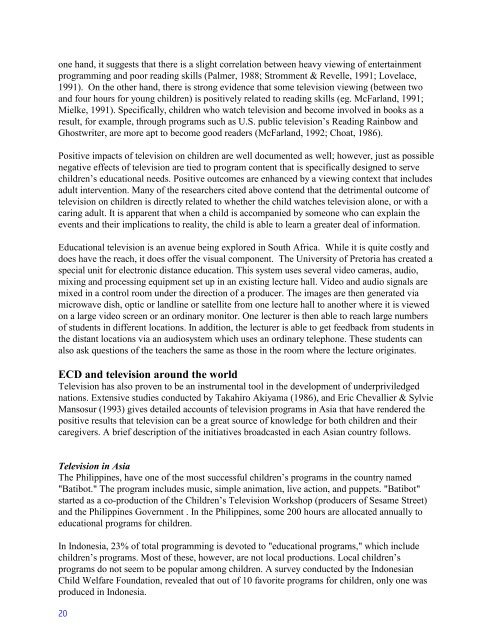SITE VISIT - Consultative Group on Early Childhood Care and ...
SITE VISIT - Consultative Group on Early Childhood Care and ...
SITE VISIT - Consultative Group on Early Childhood Care and ...
You also want an ePaper? Increase the reach of your titles
YUMPU automatically turns print PDFs into web optimized ePapers that Google loves.
<strong>on</strong>e h<strong>and</strong>, it suggests that there is a slight correlati<strong>on</strong> between heavy viewing of entertainment<br />
programming <strong>and</strong> poor reading skills (Palmer, 1988; Stromment & Revelle, 1991; Lovelace,<br />
1991). On the other h<strong>and</strong>, there is str<strong>on</strong>g evidence that some televisi<strong>on</strong> viewing (between two<br />
<strong>and</strong> four hours for young children) is positively related to reading skills (eg. McFarl<strong>and</strong>, 1991;<br />
Mielke, 1991). Specifically, children who watch televisi<strong>on</strong> <strong>and</strong> become involved in books as a<br />
result, for example, through programs such as U.S. public televisi<strong>on</strong>’s Reading Rainbow <strong>and</strong><br />
Ghostwriter, are more apt to become good readers (McFarl<strong>and</strong>, 1992; Choat, 1986).<br />
Positive impacts of televisi<strong>on</strong> <strong>on</strong> children are well documented as well; however, just as possible<br />
negative effects of televisi<strong>on</strong> are tied to program c<strong>on</strong>tent that is specifically designed to serve<br />
children’s educati<strong>on</strong>al needs. Positive outcomes are enhanced by a viewing c<strong>on</strong>text that includes<br />
adult interventi<strong>on</strong>. Many of the researchers cited above c<strong>on</strong>tend that the detrimental outcome of<br />
televisi<strong>on</strong> <strong>on</strong> children is directly related to whether the child watches televisi<strong>on</strong> al<strong>on</strong>e, or with a<br />
caring adult. It is apparent that when a child is accompanied by some<strong>on</strong>e who can explain the<br />
events <strong>and</strong> their implicati<strong>on</strong>s to reality, the child is able to learn a greater deal of informati<strong>on</strong>.<br />
Educati<strong>on</strong>al televisi<strong>on</strong> is an avenue being explored in South Africa. While it is quite costly <strong>and</strong><br />
does have the reach, it does offer the visual comp<strong>on</strong>ent. The University of Pretoria has created a<br />
special unit for electr<strong>on</strong>ic distance educati<strong>on</strong>. This system uses several video cameras, audio,<br />
mixing <strong>and</strong> processing equipment set up in an existing lecture hall. Video <strong>and</strong> audio signals are<br />
mixed in a c<strong>on</strong>trol room under the directi<strong>on</strong> of a producer. The images are then generated via<br />
microwave dish, optic or l<strong>and</strong>line or satellite from <strong>on</strong>e lecture hall to another where it is viewed<br />
<strong>on</strong> a large video screen or an ordinary m<strong>on</strong>itor. One lecturer is then able to reach large numbers<br />
of students in different locati<strong>on</strong>s. In additi<strong>on</strong>, the lecturer is able to get feedback from students in<br />
the distant locati<strong>on</strong>s via an audiosystem which uses an ordinary teleph<strong>on</strong>e. These students can<br />
also ask questi<strong>on</strong>s of the teachers the same as those in the room where the lecture originates.<br />
ECD <strong>and</strong> televisi<strong>on</strong> around the world<br />
Televisi<strong>on</strong> has also proven to be an instrumental tool in the development of underpriviledged<br />
nati<strong>on</strong>s. Extensive studies c<strong>on</strong>ducted by Takahiro Akiyama (1986), <strong>and</strong> Eric Chevallier & Sylvie<br />
Mansosur (1993) gives detailed accounts of televisi<strong>on</strong> programs in Asia that have rendered the<br />
positive results that televisi<strong>on</strong> can be a great source of knowledge for both children <strong>and</strong> their<br />
caregivers. A brief descripti<strong>on</strong> of the initiatives broadcasted in each Asian country follows.<br />
Televisi<strong>on</strong> in Asia<br />
The Philippines, have <strong>on</strong>e of the most successful children’s programs in the country named<br />
"Batibot." The program includes music, simple animati<strong>on</strong>, live acti<strong>on</strong>, <strong>and</strong> puppets. "Batibot"<br />
started as a co-producti<strong>on</strong> of the Children’s Televisi<strong>on</strong> Workshop (producers of Sesame Street)<br />
<strong>and</strong> the Philippines Government . In the Philippines, some 200 hours are allocated annually to<br />
educati<strong>on</strong>al programs for children.<br />
In Ind<strong>on</strong>esia, 23% of total programming is devoted to "educati<strong>on</strong>al programs," which include<br />
children’s programs. Most of these, however, are not local producti<strong>on</strong>s. Local children’s<br />
programs do not seem to be popular am<strong>on</strong>g children. A survey c<strong>on</strong>ducted by the Ind<strong>on</strong>esian<br />
Child Welfare Foundati<strong>on</strong>, revealed that out of 10 favorite programs for children, <strong>on</strong>ly <strong>on</strong>e was<br />
produced in Ind<strong>on</strong>esia.<br />
20
















